to Still Photography
Cinematographers have an advantage over still photographers because they get to put a different photo in front of the eyes of the viewer every 3 seconds. In a movie, especially when there is a shift in location or time, the following sequence of "crops" of the same scene and action are typically used:
Wide establishing shot
- Establishes a new scene and provides the context for everything which follows.
Medium Shot
- A loosely cropped shot in which the people in it and the background occupy the same amount of space in the frame. It identifies who in important in the scene. A "medium" shot is the most difficult to pull off effectively because if there is too much background in the shot more attention will be given to it at expense of the subject or intended center of interest.
Close-up
- Once the context of "actors" and setting are established in the two wider views, it really isn't necessary to even include the background. The camera can zoom in tighter - close enough to see the action from the point of view of an outside observer.
Cutaway
- "Cutaway" is a term of art in cinema where the point of view of the camera shifts around to see the action from the point of view of the person in the photo. Up to this point we've been impartial observers of the setting and action. In a cut-away sequence you might see a close up of two starry-eyed lovers in profile looking deeply at each other, followed by a cutaway close up of her face as seen by him, followed by a cutaway close up of his face as seen by her, followed by another "fly on the wall" close up of the two lip-locked -- fade to black - THE END.
Cinematographers think in terms of developing the story on a time line, using the different views and timing if the sequences to create a desired mood.
On a perceptual level a progression of tighter crops of the same scene has the effect of pulling the viewer closer to the action which on a emotional level tends to evoke a stronger reaction.
Still photographers, especially beginners, tend to think in terms of how to distill the story into a single perfect shot. Beginners tend to try to make every shot a medium view and as a result wind up with photos filled distractions pull attention away from the center of interest in the foreground.
The cinematic formula works well if trying to tell a complete story with a series of photos for a web page, slideshow or editorial layout. Including a wider establishing shot at the beginning of a series provides the context which allow shooting closer views without a need for distracting background context. There no need to rigidly follow the formula and shoot a scene. It is simply a way to help open up your eyes to the more complete story and how best to convey it to someone else visually so they react on an emotional level the same way. Some close-up detail might attract your attention and motivate taking the first shot. Rather than trying to add background context to what interests you grab the close-up, then back up and shoot the wide and medium shots needed to put the close-up into context. Cutaways add interest because they show a different point of view. If you are shooting a photo of someone doing something, remember to take some close-ups of their hands, tools and the view over their shoulder.
Even when the goal is one shot, shooting the different views will provide a wider range of shots to choose from. It gets you thinking about whether a shot too much or too little context and helps in spotting and eliminating unnecessary distractions.
I created the story below a few years ago using this cinematic approach:
Wide establishing shot
Medium Shot
Close-up
Cutaway
Vietnam MemorialNovember 23, 2002 |
|
This morning after taking my wife to the Grand Hyatt in Washington, D.C. for a medical meeting I stopped at the Vietnam Memorial. I had brought along my Minolta D7Hi camera because I'd been wanting to photograph it for some time and figured the low morning lighting would be ideal. I was also hoping the near freezing temperatures and twenty mile-per-hour winds would mean there wouldn't be many people there, allowing an uncluttered view of the scene. |
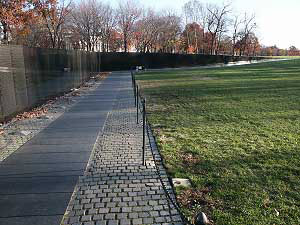 |
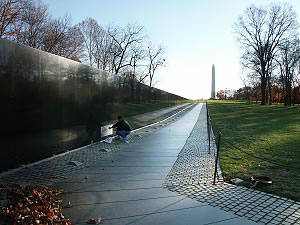 |
As I approached I found the memorial empty, save for a single person near the center who was making a rubbing of a large section of the wall. Following the advice of Robert Caputo in the National Geographic Field Guide to People and Portraits, I paused, said hello, and asked him if it would be okay to take his picture. |
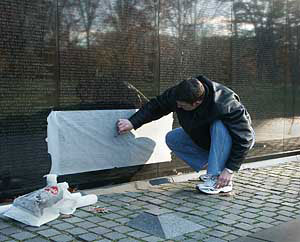 |
I took a couple photos of him rubbing an impression of the names on with a crayon and then continued down the wall to shoot some wider shots to put these pictures into context. |
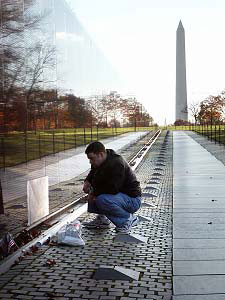 |
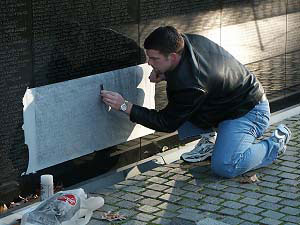 |
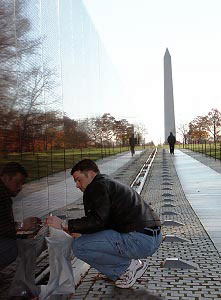 |
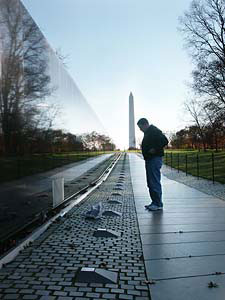 |
I returned as he was removing the rubbing from the wall and asked him if the names he had copied were those of a relative. He told me, no, that his father had served in Vietnam 1966 and made it home safely. |
|
The names, which are listed together chronologically on the wall according to the date they died, were from another platoon that his father had encountered in battle which had lost most of its members. One of them had been featured on an episode of Discovery about children who had never known fathers lost in the war. Watching the program, his father realized it was a member of that platoon who had died in his arms. After seeing the program his father had contacted the family and related what he knew about him. |
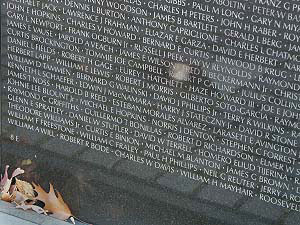 |
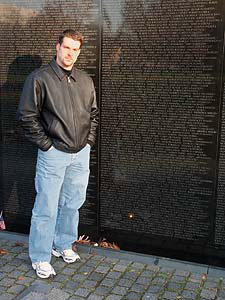 |
We introduced ourselves and I learned he was Ron Lucas from
Columbus, Georgia. He works as a drug representative and was in town
for a medical conference at the Grand Hyatt where I had just dropped
off my wife! What are the odds of that happening?
|
We were heading the same direction, so I gave Ron a ride back to his hotel and my web address so he could find and share this page with his father and others. I hope to learn the specifics of the story so I can include them. |

|
I've lived in the D.C. area since 1972 and followed the controversy surrounding Maya Lin's design for this memorial. She had a particular vision that most didn't share when they saw the design, and one I can honestly say I didn't fully appreciate until I saw the interplay of light and reflections which made the darkness of the wall disappear and merge with the sky and the surroundings. Being able to capture that with a camera and share a special moment with someone with a connection to the monument made this a very memorable outing for me. |
|
Holistic Concepts for Lighting
and Digital Photography
This tutorial is copyrighted by © Charles E. Gardner.
It may be reproduced for personal use, and referenced by link, but please to not copy and post it to your site.
You can contact me at: Chuck Gardner
For other tutorials see the Tutorial Table of Contents